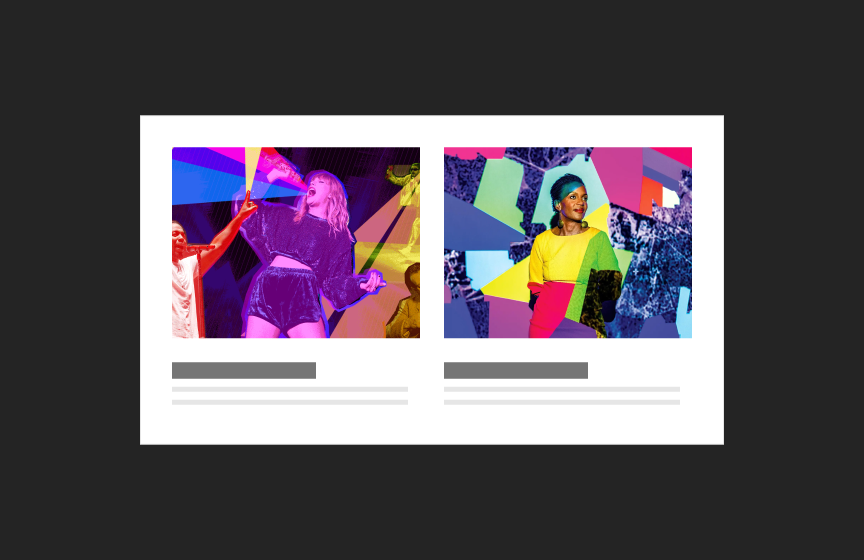Standard Card
Standard cards are the most flexible of all card types. They are used in groups and often lead to more content, including editorial content (such as articles) or different sections of a website.

Dos
Use in groups of 2 or more
Use images (text-only cards are not recommended)
Use with feeds
Don'ts
Don’t use with large amounts of text
Avoid putting cards that have images in groups with cards that don’t have images
Variations
Accessibility
Keyboard Accessible
Users are able to use the keyboard to navigate through focusable content including a linked image, headline with a link, and call to action link, using the ‘Tab’ key to navigate/focus and ‘Enter’ or ‘Spacebar’ to activate.WCAG 2.1.1: Keyboard This navigation is done in sequential and logical order. WCAG 2.4.3: Focus Order
Hover and Focus State
A linked image, headline with a link, and call to action link each have their own distinctive styling on hover/focus to provide a visual cue to the user that the element is focused and there is an action that can be taken. WCAG 1.4.13: Content on hover or focus
Responsive
The component scales in relation to the to the screen size to prevent truncating content and reflows properly when zoomed up to 200% without horizontal scrolling WCAG 1.4.10: Reflow
Color Contrast
A contrast ratio of at least 4:5:1 between text and background color is ensured to enhance readability WCAG 1.4.3: Contrast (minimum)
Consistent
Styles are applied to the card consistently including line height, font style, weight, spacing and color of text. The heights of cards are maintained consistently when cards are grouped together in a row. This provides balance and allows for greater readability. WCAG 1.4.12: Text Spacing
Image
Provide effective alt text of the image that is concise and relevant. If the image is linked, the alt text should be succinct and descriptive of both the image and the linked content. Avoid phrases like “image of” since screen readers often already announce the type of element. WCAG 1.1: Text Alternatives
Do not use an image to present text
True text should be used whenever possible, as it supports translation, is searchable, and is easier to maintain and customize. WCAG 1.4.5: Images of Text
Title
Use a clear and concise title that describes the card content WCAG 2.4.6: Headings and Labels
Body Text
Write body text in clear and simple language. WCAG: 3.1.5: Reading Level Use descriptive link text for inline-links. WCAG 2.4.4: Link Purpose (In Context)
Link
Use effective text to describe what the link is and where it is taking the user. This should be clear, descriptive text that conveys the link content succinctly and the purpose and destination of the link. WCAG 2.4.9: Link Purpose (Link Only)
- Example of effective text (preferred): Learn more about Innovate Maryland
- Example of generic text (avoid): Learn more
Disclaimer: If the visible link text is not sufficiently descriptive, you can use an aria-label attribute to provide additional context for screen reader users. The aria-label should clearly describe the link's purpose and destination.
- If the visible text is not necessary for screen readers (e.g., it's redundant or less descriptive), consider using aria-hidden="true" on the visible text element. This ensures that screen readers will prioritize the aria-label.
Example with aria-label and aria-hidden:
<a href="https://example.com/innovate-maryland" aria-label="Learn more about Innovate Maryland"> <span aria-hidden="true">Learn more</span> </a>
This ensures that the link is accessible while maintaining concise visible text.
Content
Character limit ranges
Title
50 characters (100 max)
Text Block
200 characters (400 max)
Tagline/Overline
15 characters (30 max)
Image aspect ratios
Standard Image
Can hold images with a non-defined aspect ratio
Aligned
5:4
Outlined
5:4
Layout
- Standard Cards should always be used with images. If images are not available, use an Overlay Card with no image.
- Although it is best practice to avoid using text in card images, the Standard Card is the only card recommended for images containing text. If you do not have an image available, opt for the Overlay Card instead.
Guidelines
- Helper icons should be used in Calls To Actions to indicate a non-standard action such as downloading a document or going to an off-site URL.
- Titles should link to the same URL as the Call to Action if there is one.
Animation
Hover state: Titles are underlined.
